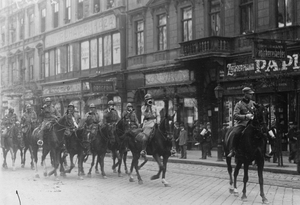Hungarian–Romanian war of 1919
| Hungarian–Romanian War | |||||||
|---|---|---|---|---|---|---|---|
| Part of the 1918–20 revolutions and interventions in Hungary | |||||||
 Romanian Cavalry in Budapest |
|||||||
|
|||||||
| Belligerents | |||||||
|
|
|
||||||
| Commanders and leaders | |||||||
|
|
|
||||||
| Strength | |||||||
| 10,000—80,000 | 10,000—96,000 | ||||||
| Casualties and losses | |||||||
| unknown dead ~41,000 captured |
3,670 dead 11,666 total |
||||||
| Romanian crossing at Prisăcani and Palanca | |||||||
|---|---|---|---|---|---|---|---|
| Part of Hungarian-Romanian War | |||||||
|
|||||||
| Belligerents | |||||||
|
|
|
||||||
Romanian victory
The Hungarian–Romanian War was fought between the First Hungarian Republic and the Kingdom of Romania from November 1918 until March 1920. The main military actions were starting in April and ending in August 1919, during the existence and the fall of the Hungarian Soviet Republic. The withdrawal of the Romanian Army lasted from November 1919 until March 1920.
At the end of 1918, the final year of World War I, the collapse of Austria-Hungary led to the declaration of the Union of Transylvania with Romania. The Romanians wanted to ensure the success of their territorial demands in the coming Peace Conference, and to help the national aspirations of the Transylvanian Romanians. The crown council in Bucharest decided in favor of an attack, and in April 1919, the Romanians launched a powerful offensive along the entire Hungarian-Romanian demarcation line, which was set according to the Belgrade Armistice of 1918. The Paris Conference decision to move the Hungarian–Romanian demarcation line forward was unacceptable to the Hungarian government, which resigned in March 1919. The Bolsheviks took power and wanted to make good on their promise to protect Hungary's borders withstanding the Entente's further demand of territorial concessions.
During the war the Hungarian Red Army also fought against troops from Czechoslovakia, though not simultaneously with the Romanians, and Yugoslavian forces occupied Hungary up to Pécs. In the war's first phase, the Romanian Army advanced against light resistance up to the Western Carpathian Mountains. In the second phase they overcame the Hungarian Red Army to reach the Tisza river. Finally, in the third phase, they defeated the Hungarian Army and ousted the communist regime of Béla Kun, after they occupied Budapest (August 1919).
...
Wikipedia
